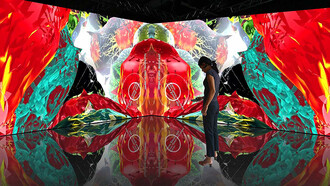Inaugurated by His Majesty King Mohammed VI in October 2014, the Mohammed VI Museum of Modern and Contemporary Art (MMVI) is the first museum institution in the Kingdom to devote itself entirely to the modern and contemporary arts and also the first public institution to respond to the International museo-graphic standards.
The architecture of the MMVI is intimately linked to the city where it is built. Located in the heart of the capital, whose architecture is at the same time marked by a specific identity but also by a rich cultural diversity, the building was born from a desire to integrate into this urban fabric. In order to do so, a conceptual approach has been adopted to harmonize the processes of modern creation with assimilated secular heritage. The traditional motifs have been reinvested and stylized to bring a contemporary touch to the building. The MMVI aims to cover the evolution of Moroccan artistic creation in the plastic and visual arts, from the beginning of the 20th century to the present day.
Since its opening, the museum hosts the exhibition 1914 - 2014: hundred years of creation, a historical panorama of the evolution of Moroccan modern and contemporary art. A chronological breakdown into four main periods has been adopted to articulate the route of this inaugural exhibition where artists such as Mohammed Ben Ali R'bati, Ahmed Louardiri, Meriem Meziane, Ahmed Cherkaoui, Farid Belkahia, Mohamed Shebaa, Mohamed Melehi, Fouad Bellamine, Mahi Bine Bine, Mounir El Fatmi and Lalla Saydi. In addition, the MMVI regularly hosts conferences and temporary exhibitions, such as Medieval Morocco: an empire from Africa to Spain since the beginning of March. The MMVI opens all week, except Tuesdays, from 10:00 to 18:00. Entrance fee is 20dhs for adults over 18, 15dhs for children over 12 and 5dhs for children. Friday is Free for nationals and foreign residents in Morocco.
MMVI building more suited to the parry of power
With its large marble slabs and low ceilings, the Neo-Gothic building is more suited to the parade of power than to the presentation of contemporary art. Finally, the chronological trajectory reveals a lack of historiographical research attested by the succinct cartels.
Let us take an example: the works of the pioneers such as Ahmed Cherkaoui, Farid Belkahia or Jilali Gharbaoui would have won a dialogue with a folk art from which they were largely inspired. "We would have liked a real scientific research," says Yasmina Naji, director of the Kulte art center in Rabat. Concretely, this is not up to what Morocco can have. And the expectations are great, as the artist Younès Rahmoun, who dreams of a "Moroccan museum for Moroccans, with an opening on what is happening elsewhere and know-how of the great museums of the world" reminds us. Mehdi Qotbi pleads indulgence: "We are learning what a museum is."
Rabat, cultural capital of Africa in Mohammed VI Museum of Modern and Contemporary Art
If you are in Rabat, you should really visit the Mohammed VI Museum of Modern and Contemporary Art. Following the entry of Morocco into the African Union, the capital of the Kingdom has just inaugurated the event Africa in Capital. It is an appointment that puts contemporary art and expressions of Africa to the forefront.
As part of this multi-disciplinary event, the Mohammed VI Museum of Modern and Contemporary Art organizes three exhibitions: A look at Africa a collection of works from a unique private collection offers an original exploration of the trends of contemporary African art. Présence Commune Congolese-French artist Kouka Ntadi and Tunisian photographer Wahib Chehata gathered in the museum and on the square, with the support of the Montresso Foundation, the fruit of a residence at the Jardin Rouge in Marrakech. Tribute a tribute to three inspiring photographers who have extinguished: Malick Sidibé with Malian Reportages, Leila Alaoui with The Moroccans and Othmane Dilami with Les musiciens de la trance.
From 28 March to 28 April, Rabat, the City of Light, the Moroccan Capital of Culture, is hosting a month of intense cultural activities: 36 highlights in some 18 places offering a rich and free program accessible to all. Exhibitions of plastic arts and heritage objects, music concerts and film screenings, lectures and urban art will be on display in the form of a real discovery trail.
Delacroix returns to Morocco in 2020 for an unprecedented exhibition
Morocco will host in 2020 an exhibition dedicated to the French romantic painter Eugène Delacroix. The President of the National Museum Foundation of Morocco (FNMM), Mehdi Qotbi: "We started to build a project for a return of Delacroix to Morocco". "Moroccans will have the chance to discover this artist who was the best ambassador of their country, who was able to transmit the culture, colors and light of Morocco to the West," he added. Discussions have been initiated with the director of the national museum Eugène Delacroix in Paris, Dominique de Font-Réaulx, who will soon be in Rabat to study the modalities of this exhibition, said Qotbi. Discussions are also underway with the Marmottan Museum to expose the Impressionist Claude Monet in Rabat in 2019, according to Qotbi. After Giacometti in the summer of 2016, the Mohammed VI Museum welcomes the first retrospective dedicated to Picasso on the African continent.















